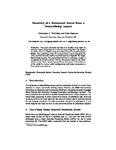Recovery of a Humanoid Robot from a Destabilising Impact
| dc.contributor.author | Wallbridge, Christopher | |
| dc.contributor.author | Bugmann, Guido | |
| dc.contributor.editor | Gao Y | |
| dc.contributor.editor | Fallah S | |
| dc.contributor.editor | Jin Y | |
| dc.contributor.editor | Lekakou C | |
| dc.date.accessioned | 2018-01-09T10:45:55Z | |
| dc.date.available | 2018-01-09T10:45:55Z | |
| dc.date.issued | 2017-07-20 | |
| dc.identifier.isbn | 9783319641065 | |
| dc.identifier.issn | 0302-9743 | |
| dc.identifier.issn | 1611-3349 | |
| dc.identifier.uri | http://hdl.handle.net/10026.1/10514 | |
| dc.description.abstract |
This paper examines the case of a bipedal robot under an external impact along the axis of the two supporting feet. The dynamics of the robot is modelled using the 3-Mass Linear Inverted Pendulum Model. The model shows that, for impacts below a given threshold, the robot recovers naturally and no corrective action is required. For larger, destabilising impacts, this paper described how to calculate a single or a sequence of corrective steps. The key information used for the calculations is the initial velocity generated by the impact. The behaviour of the model for various initial configurations and impact parameters is illustrated by simulations. | |
| dc.format.extent | 32-40 | |
| dc.language.iso | en | |
| dc.publisher | Springer International Publishing | |
| dc.subject | Humanoid | |
| dc.subject | Robot | |
| dc.subject | Dynamics | |
| dc.subject | Impact | |
| dc.subject | Corrective stepping | |
| dc.subject | Bipedal | |
| dc.subject | LIPM | |
| dc.title | Recovery of a Humanoid Robot from a Destabilising Impact | |
| dc.type | conference | |
| dc.type | Conference Proceeding | |
| plymouth.author-url | https://www.webofscience.com/api/gateway?GWVersion=2&SrcApp=PARTNER_APP&SrcAuth=LinksAMR&KeyUT=WOS:000453217100003&DestLinkType=FullRecord&DestApp=ALL_WOS&UsrCustomerID=11bb513d99f797142bcfeffcc58ea008 | |
| plymouth.volume | 10454 | |
| plymouth.publisher-url | https://doi.org/10.1007/978-3-319-64107-2 | |
| plymouth.conference-name | TAROS 2017 | |
| plymouth.publication-status | Published | |
| plymouth.journal | TOWARDS AUTONOMOUS ROBOTIC SYSTEMS (TAROS 2017) | |
| dc.identifier.doi | 10.1007/978-3-319-64107-2_3 | |
| plymouth.organisational-group | /Plymouth | |
| plymouth.organisational-group | /Plymouth/Faculty of Science and Engineering | |
| plymouth.organisational-group | /Plymouth/Faculty of Science and Engineering/School of Engineering, Computing and Mathematics | |
| plymouth.organisational-group | /Plymouth/Research Groups | |
| plymouth.organisational-group | /Plymouth/Research Groups/Marine Institute | |
| plymouth.organisational-group | /Plymouth/Users by role | |
| dcterms.dateAccepted | 2017-01-01 | |
| dc.identifier.eissn | 1611-3349 | |
| dc.rights.embargoperiod | Not known | |
| rioxxterms.versionofrecord | 10.1007/978-3-319-64107-2_3 | |
| rioxxterms.licenseref.uri | http://www.rioxx.net/licenses/all-rights-reserved | |
| rioxxterms.type | Conference Paper/Proceeding/Abstract |


